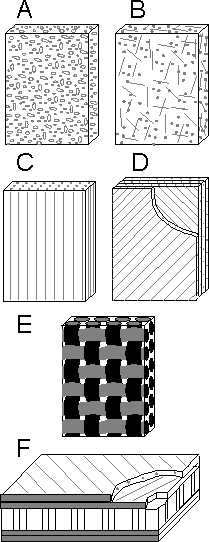 A composite material consists of two or more components. The components have different mechanical properties.
A composite material consists of two or more components. The components have different mechanical properties.
There are the following types of composites:
A. composites reinforced by particles;
B. composites reinforced by chopped strands;
C. unidirectional composites;
D. laminates;
E. fabric reinforced plastics;
F. honeycomb composite structure;
 Composite materials are widely used in aerospace structures, passenger airplanes, cars, and sporting goods.
Composite materials are widely used in aerospace structures, passenger airplanes, cars, and sporting goods.
Use of aramid fiber reinforced plastics 1, carbon fiber reinforced plastics 2, hybrid fiber (aramid + carbon) reinforced plastics 3, and glass fiber reinforced plastics 4 decreases the weight of passenger airplanes.
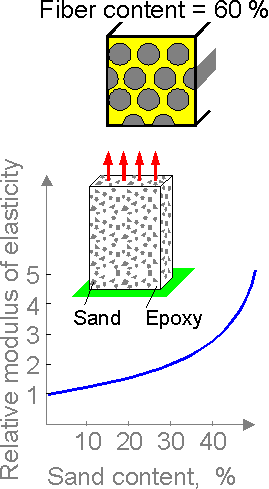 Particle content is defined by studying the cross section of a specimen. The parameter is equal to the ratio of the total area of the particles (fibers) to the cross sectional area of the specimen.
Particle content is defined by studying the cross section of a specimen. The parameter is equal to the ratio of the total area of the particles (fibers) to the cross sectional area of the specimen.
Regarding particle and fiber reinforced matrices, the modulus of elasticity will increase with larger hard particle content.
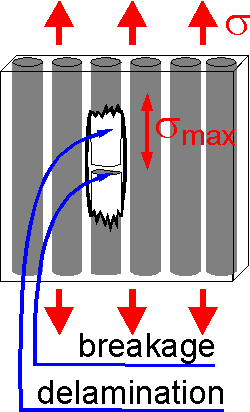 Broken rigid fibers in a flexible matrix causes a stress concentration in the neighboring fibers. The stress concentration factor increases with the difference between the modulus of elasticity of the matrix and fiber. It can range from 1.2 to 1.5.
Broken rigid fibers in a flexible matrix causes a stress concentration in the neighboring fibers. The stress concentration factor increases with the difference between the modulus of elasticity of the matrix and fiber. It can range from 1.2 to 1.5.
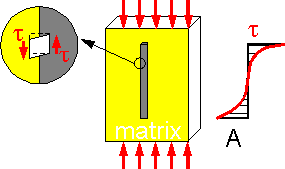 There are shear stress concentrations at the bond surface between components.
There are shear stress concentrations at the bond surface between components.
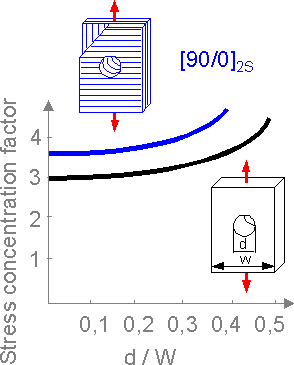 Stress concentration in laminate materials is higher than in isotropic materials. Hence, the strength of a notched composite specimen is rather high.
Stress concentration in laminate materials is higher than in isotropic materials. Hence, the strength of a notched composite specimen is rather high.
The notation [0o/90o]2S means the laminate is assembled with two layers oriented at 0o and 90o.
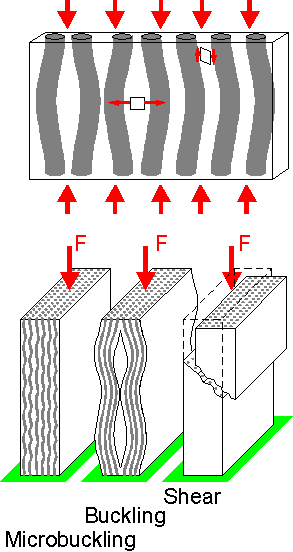 Tensile and shear stresses cause different failure scenarios for composite structures.
Tensile and shear stresses cause different failure scenarios for composite structures.
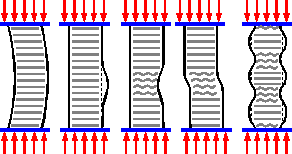 Honeycomb composite structure has high flexural strength. Mechanisms of stability loss under compression depends on many factors such as adhesive quality, size of honeycomb, fiber filament, etc.
Honeycomb composite structure has high flexural strength. Mechanisms of stability loss under compression depends on many factors such as adhesive quality, size of honeycomb, fiber filament, etc.
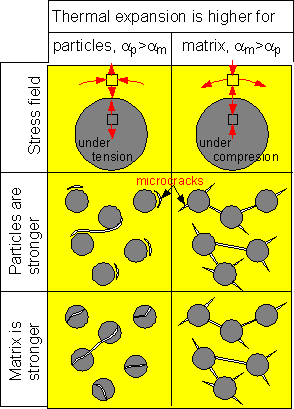 There is a residual technological microcracking in composites reinforced by particles. If thermal expansion is high for particles, then the particles are under compression after cooling. Weak particles contain internal microcracks. If the matrix or bond border is weaker than particles, there are tangential microcracks in the matrix and at the border.
There is a residual technological microcracking in composites reinforced by particles. If thermal expansion is high for particles, then the particles are under compression after cooling. Weak particles contain internal microcracks. If the matrix or bond border is weaker than particles, there are tangential microcracks in the matrix and at the border.
FIBERS
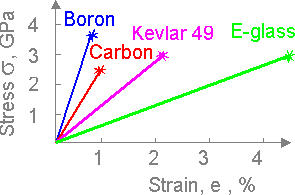 Fibers demonstrate unique mechanical properties: modulus of elasticity and strength.
Fibers demonstrate unique mechanical properties: modulus of elasticity and strength.
The critical force for a fiber is equal to the production of critical stress (strength) by the fiber area.
Knotted aramid fiber keeps up to 50% of its original strength. Other fibrous material are more brittle.
There is small effect of temperature and deformation rate on strength of brittle fibers such as boron or SiC.
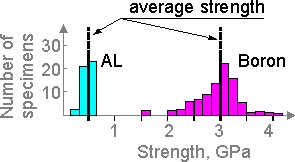 Fibers differ from other structural materials due to a larger scatter in experimental data.
Fibers differ from other structural materials due to a larger scatter in experimental data.
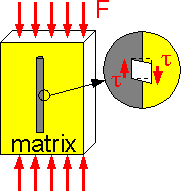 Shear stress causes fracture of the fiber-matrix bond.
Shear stress causes fracture of the fiber-matrix bond.
Usually fibers are round. Larger bond surfaces between matrix and fiber corresponds to higher crack resistance of a composite material.
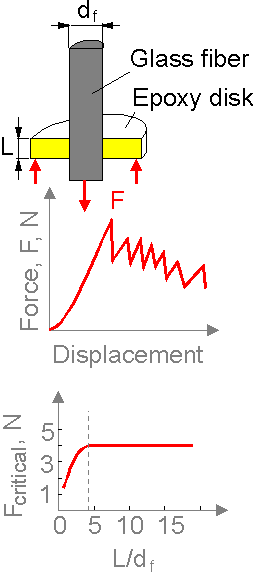 Effect of friction between matrix and fiber after bond fracture is reflected in a В«force-displacementВ» diagram. Critical forces depend on bond length for small L only.
Effect of friction between matrix and fiber after bond fracture is reflected in a В«force-displacementВ» diagram. Critical forces depend on bond length for small L only.
 2015-08-13
2015-08-13 473
473








